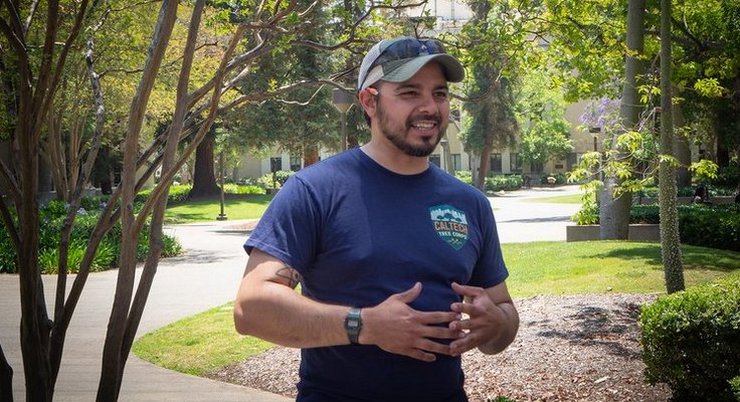
“Urban forests can cool our urban areas by as much as 10 degrees, blocking ultraviolet light, and offsetting the ‘heat island’ effect,” Vejar said. “Trees transpire water into the immediate air, further cooling the surrounding area and decreasing cooling costs. Trees sequester carbon from the atmosphere, acting as a mitigating factor to climate change.”
Vejar, Caltech’s own arborist and an organizer of the Caltech Tree Corps this year, will be emceeing an event on Friday, Aug. 12, that focuses on the “True Value of our Urban Forest” – especially Pasadena’s urban forest. The event will be held in person at the Patagonia store located at 47 N Fair Oaks Ave. in One Colorado.
With this event, Vejar and the members of the Caltech Tree Corps want to engage the community directly, and to help people recognize the value of the trees around them.
“I think it’s fairly common (that) we walk beneath trees and pay them little attention, unless we are in dire need of them,” Vejar said. “Trees may seem like unchanging, invulnerable ornaments in our landscape. But without sustained resources and management, our urban forest will wither and we will lose decades, generations of ecological value from the places where and when we need it most. If we want our cities and neighborhoods to remain habitable, we as a community have to support tree-oriented policy, we have to prioritize our canopy, and maybe we should pick up a shovel and get to it.”
Vejar started working at Caltech in 2019, but before that, he ‘climbed trees’ at Disneyland. He and the rest of the arborist crew pruned trees around the park after closing time and checked for loose branches that could fall and hurt visitors.
‘Right Tree, Right Place’
Unlike a natural forest, which regenerates and replenishes by itself, an urban forest is exactly the opposite: it requires planning, maintenance and upkeep on a regular basis.
For Vejar, urban forests are valuable in terms of the many benefits they provide and the community must be constantly encouraged to care for the trees and to plant more of them.
“We are fortunate that our city already has a fairly well-developed urban forest,” he said.
“But unlike natural forests which tend to sustain and regenerate themselves, urban forests necessitate planning and maintenance in order to gain the most value from the trees. That means we must focus our efforts in reaching out to the community, spreading the awareness of the value of trees.”
He said with public and municipal land making up only about 10 to 20 percent of a city, private property owners must be strongly encouraged to plant and maintain their own trees.
“Most people absolutely adore trees – until you ask them to plant on their own property,” Vejar said.
Caring for a tree doesn’t end with simply digging a hole and placing a tree in it, he added. A mantra that every aspiring nature lover and tree caretaker should remember is “Right Tree, Right Place,” he said. The caretaker should also ask himself how much space is available, what are the watering requirements, is it a native species or something foreign, how large do you want the tree to get, and many other questions.
“There are many other species considerations; no tree is ‘perfect’ for every planting site, each species has pros and cons,” Vejar said. “But a little bit of consideration, and maybe some insight from your local arborist, will go a long way toward ensuring your trees have the absolute best shot at reaching maturity.”
Many of the things involved in tree-caring may not be discussed at the event on Friday, but it will certainly be an awakening event, and Vejar hopes it will start serious conversations on how inappropriate ways of tree pruning and urban forest management have been doing more harm than good.
“Trees are not eternal. They’re vulnerable to all kinds of environmental insults and cultural and social practices of all kinds of different people, and topping trees and over-pruning trees that can lead to declining the health of trees,” he said. “In fact, our industry is really at a crossroads right now because so many trees in so many years have been over-pruned because it was the cosmetic trend. And now we’re finding out that we have to allow trees to really leaf out and become larger in order to get the full value from them.”

At the event on Friday, Vejar will be discussing Caltech Tree Corpss endeavors in setting the standard for tree preservation in the built environment. Acclaimed woodworking artist Darin Beaman, of Former Studio, will be displaying his craft and discussing his connection with the urban forest. Caltech’s Sustainability Manager Max Christman will be outlining campus efforts toward sustainability and what it takes to lead the charge toward a greener future from within the historic institution.
Finally, Michelle Bagnato, TreePeople’s Senior Urban Forestry Manager, will expound on the group’s reforestation efforts in the Greater Los Angeles area while highlighting the role of trees and their stewards at the intersection of environmental and social justice.
The conversation begins at 6 p.m.
To RSVP for attendance, visit https://truevalueofoururbanforest.splashthat.com.
To learn more about the Caltech Tree Corps, visit https://treecorps.caltech.edu.



















